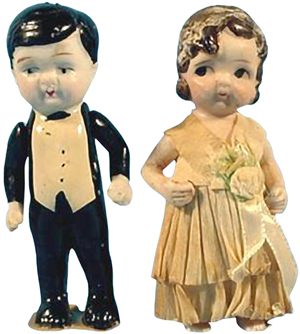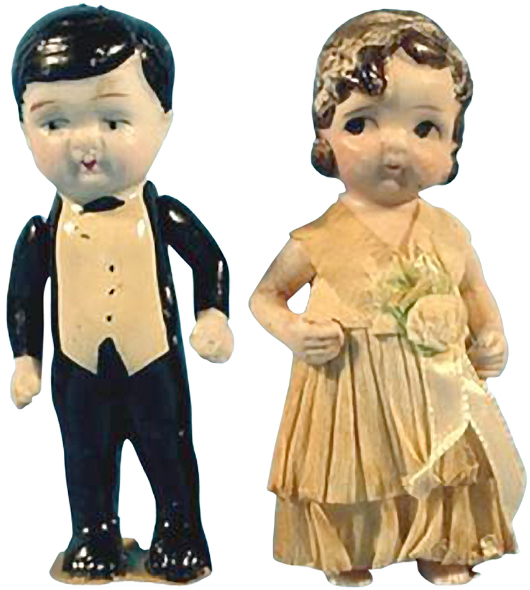
The bride and groom topper on a contemporary wedding cake often is made of plastic or sugar. But the traditions of wedding-cake toppers and even wedding cakes do not go back very far. The sweets served at weddings centuries ago included barley bread, sweet rolls or pies. Later, fruit cakes were served, and, by the 1600s, dessert cakes. In the 19th century, white icing was expensive because of the high cost of refined sugar, so it was served only by the rich.
The modern wedding cake became fashionable in the 1880s, but the bride and groom topper wasn’t introduced until the 20th century. Early figures were made of bisque, composition (like that used for dolls), chalkware or a sugar mixture called “gum paste.” The groom wore a tux or tails and a top hat. In the 1920s, small bisque kewpie figures were dressed in crepe paper to represent the couple. The bride usually wore a lace cap and a long veil. In the 1940s, the war influenced topper designs and materials. Plastic toppers were introduced. The bride wore a fashionable dress with lace, and the groom was hatless but might be in tails. Soldier, sailor and other military uniforms were chosen for military weddings. All-sugar figures returned, and a few porcelain sets were made. Today’s toppers are plastic, sugar or even porcelain figurines by Lladro or Lenox that can be kept for life. Old toppers are inexpensive but hard to find.
Q: When my wife and I married in 1948, a close relative gave us a new four-piece bedroom set as a wedding gift. The set includes a double-bed frame, a mirrored vanity with an upholstered bench and a five-drawer chest. The furniture was manufactured by Showers Furniture of Bloomington, Ind. Does a set like this have any value?
A: The history of Showers Brothers Co. can be traced back to the 1850s, when Charles Showers opened a cabinetmaking business in Bloomington. His sons, William, James and Charles Jr., took over the business in 1868. Business expanded between the 1880s and the 1920s and Showers grew to become one of the largest furniture manufacturers in the country. Showers was bought out in 1955 and closed for good in 1958. One of its factories is today the site of Bloomington’s City Hall. If you want to sell your bedroom set, it is easiest to sell it locally. Try posting an ad online. Depending on its style and condition, you might be able to get a few hundred dollars for it.
Q: I bought what I thought was a set of coin silver flatware back-stamped “900.” But the pieces are attracted by a magnet and I have been told that means they’re not really coin silver. Is that true?
A: “Coin silver” has a slightly lower silver content than sterling silver. Pure silver is too soft and must be alloyed with copper for strength. Sterling is .925 parts silver, while American coin silver is .892 to .900 parts silver. Coin silver was the silver standard common in the United States from 1792, when the U.S. Mint was founded, until the 1860s, when American silversmiths reverted to the English sterling standard they had used before the American Revolution. Neither silver nor copper is attracted by a magnet. Some spelter, a white metal alloy that looks like silver, does attract a magnet. Your flatware is probably spelter.
Q: I have a small bronze vase that is about 3 inches tall and has raised work on one side. It is marked “Lauchhammer,” with a crown over the name and crossed hammers beneath it. I would like to know who made this vase.
A: A bell and art foundry was established in Lauchhammer, Germany, in 1725. Bells, bowls, boxes, candlesticks, mirrors, plaques, sculptures, statues and other items were made in bronze, brass, iron, nickel, tin, zinc and other metals. The foundry is still in business, operating under the name Lauchhammer Kunstguss.
Q: A few months ago you wrote about a Bonnyware red plastic biscuit cutter marked “For Bisquicks.” You asked if anyone had more information about the Bisquick cutter. My aunt collected biscuit and cookie cutters for years. One of her books, “Cookie Cutters and Cookie Molds: Art in the Kitchen” by Phyllis Steiss Wetherill, explains that Bonny Ware (two words) was a brand name for a hard plastic used in 1932 to make round biscuit cutters as product premiums for General Mills’ Bisquick baking mix. A customer could mail in one Bisquick box top and receive a 2 3/8-inch green cutter and a 1 5/8-inch white cutter. Wetherill says a 2 1/8-inch yellow Bonny Ware cutter was sold in the General Mills company gift shop.
A: We have a copy of Wetherill’s book in our library and didn’t know it discussed Bonny Ware until we read your letter. A recent article in the Jackson (Mich.) Citizen Patriot confirms that Bonny Ware, a molded plastic, was made by the Reynolds Spring Co. of Jackson. Reynolds Spring’s plastics division opened in 1922 and made plastic products of all kinds. In the late 1920s or early ’30s, the company introduced Bonny Ware, a line of plastic dishes and kitchenware that came in red, orange, pink or green. Pieces were marked “Bonny Ware.” The newspaper article says that Bisquick gave away the cutters “in boxes … for years.” Anything marked Bonny Ware is collectible.
Tip: Wash your hands before handling paper collectibles. Wipe off the table before you put valuable papers down on it. There are mold spores in dirt and dust.
Sign up for our weekly email, “Kovels Komments.” It includes the latest news, tips and questions and is free if you register on our website. Kovels.com has lists of publications, clubs, appraisers, auction houses, people who sell parts or repair antiques and more. Kovels.com adds to the information in this column and helps you find useful sources needed by collectors.
Terry Kovel answers as many questions as possible through the column. By sending a letter with a question, you give full permission for use in the column or any other Kovel forum. Names, addresses or email addresses will not be published. We cannot guarantee the return of any photograph, but if a stamped envelope is included, we will try. The volume of mail makes personal answers or appraisals impossible. Write to Kovels, Auction Central News, King Features Syndicate, 300 W. 57th St., New York, NY 10019.
CURRENT PRICES
Current prices are recorded from antiques shows, flea markets, sales and auctions throughout the United States. Prices vary in different locations because of local economic conditions.
- Holt Howard salt and pepper set, men, Old West style with beards and cowboy hats, glazed terra cotta, 6 inches, $20.
- Doll bathinette, Happy Time, yellow vinyl, metal folding frame, moveable cover shows little girl bathing toddler, sold by Sears, Roebuck & Co., 1950s, 32 x 21 inches, $65.
- Trolley sign, Cleveland Baking Powder, cardboard, image of muffins and baking powder can, “Easy to make with Cleveland’s,” 1920s, 11 x 21 inches, $90.
- Victorian marriage certificate, flowers and angels, wedding bell with inscription, Michigan, May 18, 1898, 20 x 15 inches, $120.
- Elephant bookends, cast iron, trunks up, Hubley, 1920s, 5 1/8 x 5 1/4 inches, $165.
- Blue Staffordshire plate, “The Landing of General Lafayette,” floral border, impressed “Clews,” 1880s, 10 inches, $200.
- Carnival glass water set, Windmill pattern, marigold over clear, 8-inch pitcher, nine glasses, $400.
- Jane Withers doll, open mouth, six upper teeth, brown mohair wig, sleep eyes, Madame Alexander, 1930s, 20 inches, $595.
- Pier table, gray and beige marble top, serpentine front edge, three polychrome floral panels, wrought-iron S-scrolled supports, 1930s, 31 x 39 inches, $630.
- Sterling-silver serving spoon, Bird’s Nest pattern, gold-wash bowl, simulated branch handle ending in bird’s nest with perched bird and three eggs, monogrammed, box, 10 1/2 inches, $1,840.
Order the set: “Buyers’ Guide to 20th Century Costume Jewelry,” Part One and Part Two. Both for our special price of $34.95. These special reports help you identify the most popular makers and designers of costume jewelry. Spot mid-century costume jewelry, Mexican silver jewelry and European and North American pieces. Learn who Hobe and Sigi are and how to recognize a rare piece of Bakelite. Accurate, comprehensive and valuable whether you’re a serious collector or just a beginner. Available only from Kovels. Order by phone at 800-303-1996; online at Kovels.com; or send $34.95 plus $4.95 postage and handling to Kovels, P.O. Box 22900, Beachwood, OH 44122.
© 2012 by Cowles Syndicate Inc.
ADDITIONAL IMAGE OF NOTE


